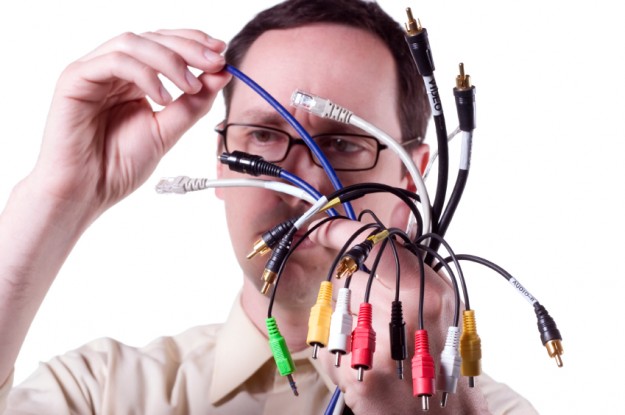
Many of you may remember my post from the summer of 2009 when I found some HDMI cables for as little as 17¢. By the way those cables are still working great! As a matter of fact I made sure to tell my friends and family NOT to be suckered into buying cables during the holiday season from the same retail outlets that they may be buying their holiday tech gifts from. In this price competitive landscape retailers often use things like cables to make up for lost margins on higher ticket items like HDTVs and Bluray players. For example, I laughed out loud when I cruised through my local Best Buy and saw this "great" deal on a Monster HDMI cable:
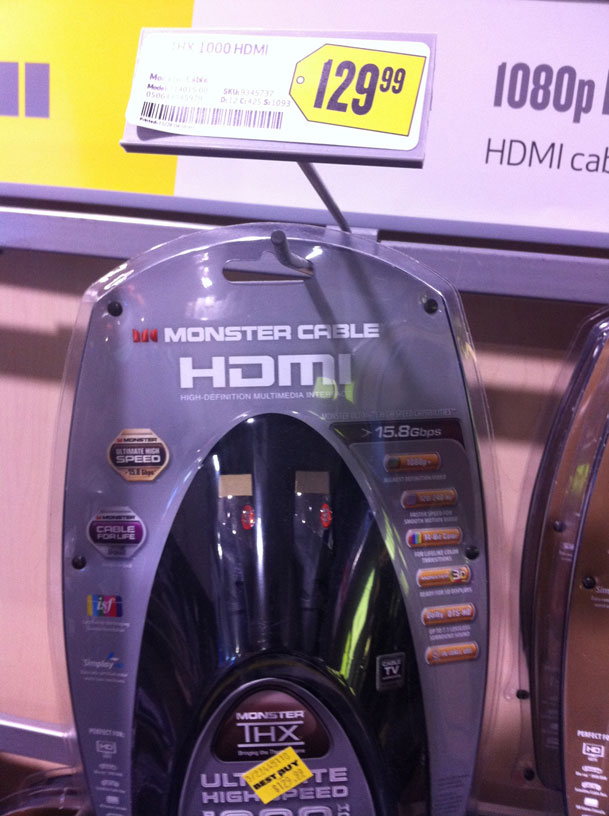
So Monster, let me get this straight…
You can get an Apple TV for less than $99. You can now get Bluray Players for less than $90. Yet you would have us believe that there is more expensive technology in your "cable" than the device it's being connected to? The bottom line is with ALL HDMI cables they are digital sending 0's and 1's. They either work or they don't! Here's a great post that explains the rip off even further.
By the way, although the cables I bought back in 2009 (I have a drawer full of them) are no longer 17¢, they are now only going for a few bucks here.
The Cheaper HDMI Cables Even Outperformed the GE Branded HDMI Cables
What? How does an HDMI cable outperform another one if it's all digital? OK, maybe "outperformed" is the wrong word. Let's say "more compatible". Over the holiday break I got the pleasure of setting up a NEW HDTV and receiver with all HDMI connections. I went to my HDMI drawer and grabbed the 4 cables that I needed. I hooked everything up and everything worked great. Although everything worked, there was one slight problem. Three of these components were literally either right next to each other or on top of each other and the 6 foot cables were longer than I wanted them to be. I remembered seeing some 3 foot cables at my local hardware store and they were reasonable priced around $8 each. I headed over and bought 3 of them to replace the longer ones. I plugged them in and everything was working once again. Later that evening I rented a movie via Apple TV in HD. However, when I went to watch it I got a warning I had never seen before:
"This content requires HDCP for playback. HDCP isn't supported by your HDMI connection."
WTF! Basically what this message means is that the HD Copy Protection signal isn't making its way from the Apple TV to the receiver/HDTV. I tried all the usual stuff of rebooting, restarting, etc. etc. and then it dawned on me that the only thing that had changed was the cable. I went and grabbed one of the no name HDMI "cheap" cables and replaced the GE branded cable and the movie rental played fine! It's hard to believe that there would be any cables on the shelves today that don't support HDCP, let alone from a name brand like GE, but there you have it! If you want to read more about this error, see this tech note.
It's not just HDMI Cables either!
A couple of weeks ago I finally decided to run that 100' Ethernet cable from one end of my house to the other between floors that I have been putting off for years. Of course I needed to buy the Cat6 100 foot cable to do the job. Normally I don't think about the price of Ethernet cables. There's a Staples within walking distance of my house and I typically run over there when I need a network cable. However, since it was going to be such a long cable I wasn't even sure if they carried them in stock in that length. I headed to website and sure enough they do have them, but then I saw the price:
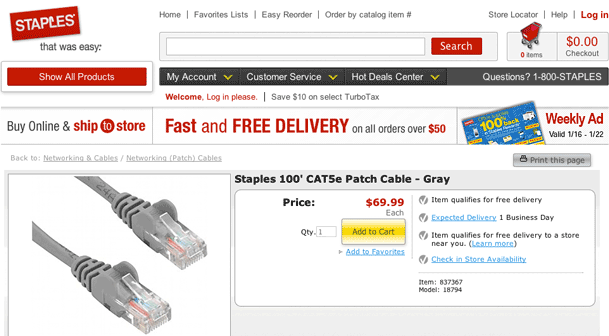
It was $70!
I decided to check with my local Micro Center for a sanity check:
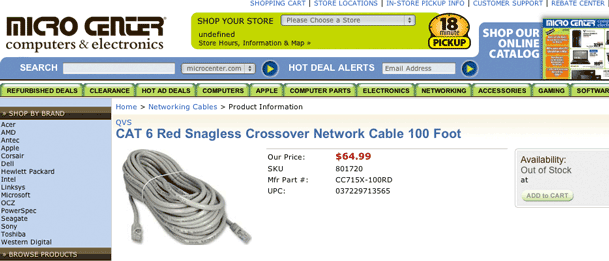
While they were a little cheaper at $65, the cable wasn't even in stock.
Then I wondered, "are they cheaper elsewhere?"
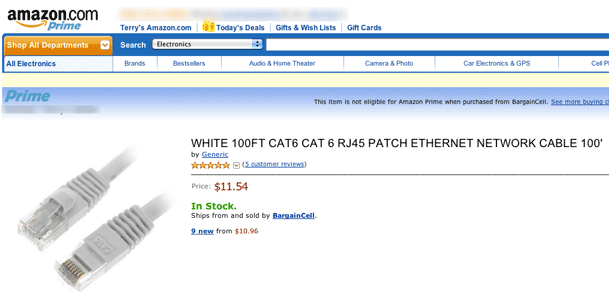
Sure enough they were. While it would mean ordering online and having to wait for it to be shipped (darn, I'd have to put off that chore a little longer 🙂 ), the savings would be worth it. Yes, this cable that I bought (heck, I ordered two) arrived a couple of days later via Priority Mail and is working fine. By the way, the 7 foot Ethernet cables at Staples go for $19.99!
This is just a reminder! More expensive cables don't necessarily work any better or last any longer, especially digital ones. Don't pay too much!
UPDATE from Twitter follower @photoandmac
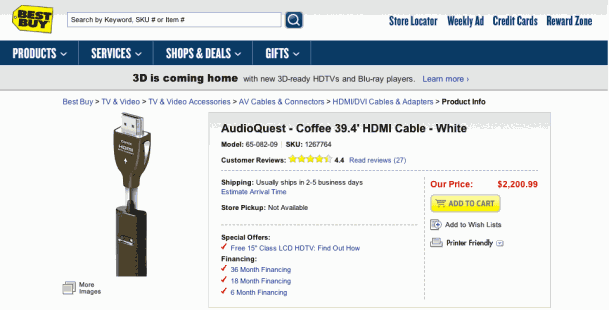
You know you're in trouble when they offer "Financing" for your HDMIcable! 🙂 Ooooooohhh, Ahhhhhhhhh! I'm not making this up! This 39.4 foot HDMI cable goes for $2,200.99. Here's the link.


I’m a big fan of monoprice.com their prices are amazing and the quality is very very good!
Those are some good prices! Thanks! I just placed an order for some short cables.
Have to second the recommendation of Monoprice. Great prices and great service, and a lifetime warranty on their cables!
We use http://www.pccables.com/ and have good success with everything we have bought. Thanks also for the monoprice link also.
Same here, big fan of monoprice.com. Just bought two DisplayPort adapter cables from them that I should hopefully be receiving tomorrow.
ditto on http://www.monoprice.com for value and low shipping costs
Thanks, Terry. I’ve laughed at people for years who paid exorbitant prices for cables. It has to be one of the best snow jobs the industry has ever foisted off on the consumer. And yet I know a couple of “audiophiles” and “videophiles” – their name for themselves – that will swear they can tell the difference between the cables with the gold plated contacts versus the silver ones… And nothing you can say or do can dissuade them. Both got their start on this path years ago when Monster Cables convinced everyone that having like welding cable (de-oxygenated copper of course) with gold plating (and a golden price point) would make your audio sound better by reducing “skin effect”. Not to bother with the fact that skin effect – which actually does exist – only happens at UHF and higher frequencies, far, far above the range of human (or any other creature’s) hearing. Crazy. So thanks for helping de-bunk the myth and hopefully some of your readers can save some serious dough.
This can work for car parts too. I found lift supports, those shock absorber shaped things that keep your rear hatch or sometimes front hood up, for $20 a piece instead of $40 a piece.
Terry, Finally I can show hard facts to my friend that always chant about the performance of his cables 😉
Thanks mate
Terry
Great write up on the HDMI cable rip off. I bought a 4 foot HDMI cable to connect my new apple TV to my TV for $9 (shipping included) from Amazon.com. I had a co worker explain to me that the picture was better from his PS3 to his TV with the $100 cable than with the $10 cable I bought. Honestly, even if the difference is a little bit more detail in the shadows (his explanation), I am not sure its worth $90 to see that difference!
Leland,
Unless his $100 cable also has chips in it to reprocess the 1’s and 0’s, your $10 cable is going to be the EXACT same picture 🙂
I have to laugh. I remember purchasing something at Best Buy and the guy pulling out his clip board with a cable chart on it, and a choice between cheap, mid range and premium cables. The cheap option was still a couple hundred dollars! What a money maker.
I recently bought from Amazon as well. They have their own line called AmazonBasics, a 6 ft cable runs $8.
We needed a 50′ Ethernet cable and of course thought Office Max. Well it was just about $1 per foot. So… not needing it that badly, we went across the street to the hardwear store and as an after thought decided to check what they might have. To our surprise, not only did they have the exact same namebrand product BUT it was $10 regular price! So needless to say they are now our first stop for cable needs. How weird is that?!?!
If you need it right now, Home Depot kills the big box stores, they have 15′ ethernet for $6.98. Also, they have it by the foot and carry the connectors and the crimping tool to roll your own.
Some people see the value in the Mac. To push the state of the art beyond the mundane is expensive. The further you push it, the more expensive it becomes. Some both understand and appreciate the difference and they buy Macs. Others laugh at the thought.
The same can be true of cables. No, maybe not with a $500 TV from a wholesale membership store. Maybe not, if you are using the DVD player in your computer. Maybe not if you don’t know what to look/listen for. Maybe not if your listening and viewing experience falls into the category of the mundane.
However, “to push the state of the art beyond the mundane is expensive. The further you push it, the more expensive it becomes. Some both understand and appreciate the difference and they buy [these kind of products.] Others laugh at the thought.”
If you don’t “get it”, don’t buy it.
I’ve been using meritline.com most recently with great success on cables and so forth.
We just had this same conversation in my office last week when I showed a co-worker the “financing available” on the best buy HDMI page!
I will put in another recommendation for monoprice.com. Since I found that site a year ago I have ordered from there numerous times with great results (and low bills). In fact, I have become the go-to cable guy for all of my friends and family as a result… be careful what you wish for!
BTW, if you have a minute, check out the killer reviews on the $2,200 cable from Best Buy. Some of the better ones are:
CHUCK NORRIS DOESNOT EVEN HAVE ONE!!
My ATARI has never looked better.
I cried after plugging it in
Another possibility for ethernet cables is to simply buy 500 feet of cat 5, a box of connectors and a crimping tool. At the prices that some of these places charge, that stuff would have a street value of a $10,000. 🙂
For those considering making DIY network cables with a nice cheap box of Cat 5 cable from Home Depot: Note that Cat 5 will not carry gigabit ethernet, which is becoming more and more important as people try to move large video files around the house, and stream HD video, etc. You need at least Cat 5e (that last “e” is critical), and Cat 5e connectors, or better yet, Cat 6, which is more expensive.
Cables can make a difference with audio gear. If you have mass market gear, you probably wouldn’t notice.
For computer/digital stuff, I agree, it makes little difference. Although big fat SCSI cables WERE better than the skinny out-of-the-box variety. I will pay extra for ethernet cables with reinforced jack ends. The cheap ones can pull loose or break.
Monster is a ripoff, for sure!
Another vote for monoprice!
So back a few months ago before this link resurfaced, (Dec MacGroup meeting) I had just purchased a new TV and went through the same pain and agony of cables. Before I asked the question at the meeting , I asked our office IT guy the same scenario. He then told me of the NEW HDMI 1.4 cables. INDUSTRY STANDARD! I was told.
Remember the scene from Men In Black when the 2 dudes open the locker at the train station. What I envision is Terry opening that door and we all hailing “Terry White,,,HDMI,,,,Terry White HDMI !!!!!” and a big long HDMI cable wrapped thru the masses.
While I agree with the “concept” of your article, I disagree with most of the “logic” behind it.
First,
Yes, I agree that companies like Monster Cables ARE overpriced, you are paying for the name brand. Stores such as Best Buy, mark them up even further, I can attest to that since I used to work there and got an employee discount of 30% above cost, and accessories are where they make the REAL money! I am talking hundreds of percent markup. Those monster cables are more like $30 – $50 ranges I can’t remember exactly, it has been a while…
Second,
To say one cable can tell the difference between protected content being delivered is absolutely absurd! There are no chips or processing power in the cable, even as you stated, it is simply delivering data. There had to be something else that was occuring to give the error of “HDCP content”. To say that the cable knows the difference, is like saying an antenna (a piece of metal) can tell the difference between HD and SD content. Do you REALLY think an antenna cares? NO, and neither does the cable!
Third,
There is technology involved, which CAN lead to increased prices. If there was no technology involved (especially with ethernet cables) then that would lead to say that there is no difference between Cat5, Cat5e, or Cat6 cables. I can tell you for a fact there IS. The technology improves the THROUGHPUT, while outside variations can decrease the GOODPUT. Cat5 can only perform UP TO 100Mbps due to the twisting of the wires in that cable, Cat5e UP TO 1000Mbps, and Cat6 10Gbps. The technology resides in those twists which reduce cross-talk and interference are the end result of the throughput. Is there not technology in other cables such as HDMI? Of course gold is a better conductor than copper. To say that there isn’t is again, absurd. Is the average person going to be able to tell the difference? Probably not, but for those who can, or those that want to know that they have “constructed” a great theater system or network. Then that is for them to decide. There is a technology difference involved, but then marketing is the rest.
I DO appreciate your experience with the cheaper cables and love the input, as well as everyone posting sites for cheaper cables, I will keep those in mind when purchasing cables. I too have had good luck with cheaper cables, when I use them on something I’m not concerned with it being “the best”, but again, the “logic” of this article seems a bit off to me…
In this day and age, the only difference for minor price differences is the quality of the connectors. I’ve seen some where the plastic connectors were very brittle and needed careful attention to keep them from breaking. I’ve seen cheap and moderately priced cables that the connectors would last forever. The really expensive cables have a great mark up, advertising budget, and good salesman commission. A saleman will sell you a decent cable for your new machine because they don’t want the machine returned. In short find a company you like and stay with them. From a former computer salesman….
Dear Terry,
I am a regular visitor at your blog and you do have some really informative articles.
However, I respectfully disagree with some of your logic here. When you are buying a cable worth $130, its not meant to be used with your Apple TV/gaming consoles. When you say its digital, its not just about the 1’s and 0’s but it also depends on how fast you can get those bits to reach the receiver and how far the receiver is. BTW, I have never used an apple TV but from the specs I see that it supports just 720P video from HDMI (pls correct me if i am wrong). That is not even full HD and no wonder it works perfectly fine with those cheap sub-$10 cables. Anyway, returning to my previous point, the capability to support a high bandwidth over a certain distance is the main thing that differentiates various cables. Are Monster cables overpriced? $130 seems like a lot and I am sure that their actual price is much less before retail. But, is there a difference in quality when compared to the cheap cables you mentioned.. Definitely! Show me an 8′ HDMI cable that can transmit 1080P along with uncompressed HD sound formats such as DTS HD master audio and driving a 240Hz display. Not to mention the additional headroom left in terms of bandwidth for future expansions or support for newer formats with greater bandwidth requirements and a tough build?
Customer awareness is the key point here. You dont have to buy a $130 cable to drive your $500 TV and a 90$ Blu ray player. But for someone spending over $2000 dollars for the display, another $1000 for the AV receiver and hundreds for a fully featured blu ray player, a $130 cable is a small price to pay to insure maximum compatibility with all the standards that each of these devices support. Moreover, such high end equipment can easily expose the cheap quality of the cabls if they are not up for the task. Its like saying that I dont want to buy a Porsche when I can get a Civic for a fraction of the price! You say that because you either cant afford the Porsche or you dont fully understand what more you are getting for the price you pay.
Its an old debate and I am sure it wont die anysoon. So keep the arguments coming 🙂
Best Buy sells $2,000 displays. Magnolia, their sister company, sells $1k AV receivers. But they also sell $99 AppleTVs and $300 displays. And their cheapest connectors are still absurdly prices. None of these are unusually expensive, or particularly “special”. It’s true that the AppleTV is only 720p, but even the cheapest BluRay player is pushing a full 1080p video signal plus uncompressed audio down that HDMI cable.
In the digital realm, for AV cables it still all comes down to cable length. For a typical setup, whether the TV was $5k or $300, the distance from the TV to the BluRay player is going to be well with the distance easily covered by a 12′ cable (if not a much shorter 3-6′ cable). The inexpensive HDMI cables at Monoprice will pass the EXACT same 1s and 0s as the hideously expensive Monster Cables, or even the “high quality” cables from relatively reasonably-priced premium cable providers such as Blue Jean Cables, etc. I’ll ignore the true high-end audiophile cables for the moment, as they’re not relevant to a discussion primarily about HDMI cables.
There is an argument to be made for gold connectors, etc., in terms of oxidation, and the quality of the connectors, strain relief, etc. But in the end, if the picture passed by the $4-8 Monoprice cable is the same as the one passed by the $100 Monster Cable or the $18.50 Blue Jean Cable one, why do you need to spend the $100 even if it is connecting a $500 BluRay player to a $5,000 TV? Somewhat more expensive components are still using the same sorts of signal, and data sources (DirecTV, BluRay, HT computers, etc) as the cheaper ones. 1080p is 1080p, whether it’s feeding a $100 Acer LCD computer monitor or a $6k Plasma TV. And considering you buy 2, 3, or sometimes 20 or more of the cheaper cables for the cost of ONE of the high end cables, longevity and long-term oxidation generally aren’t huge concerns. (And one dropped tool landing on the expensive cable will kill it just as surely as the the cheap one… but guess which is cheaper to replace?)
Long runs are completely different. You DO need to spend extra on a higher-quality cable there (again, not Monster). Normal, short runs, however, do not matter. There is NO need to spend extra on special cables, outside of truly special needs. It doesn’t matter how expensive your components are.
Two exceptions worth noting (outside the length exception): Data cables and analog cables.
With network cables, quality counts more. I’m not saying everyone needs to spend large amounts of money on Belkin Cat 6 ethernet cables, but saving money by crimping your own, or buying the cheapest you can find online, isn’t necessarily the best answer. If you want to transmit gigabit ethernet rates, you’ll need a decent quality Cat 5e, or better yet, Cat 6 cable. The better cables have better strain relief, easier-to-use connectors, etc. (Belkin actually is best in the area, although I do also like the quality and usability of the network cables from Cables4Less as well)
The second exception is analog signals. A higher quality cable CAN make difference here. Again, though, distance matters, as does the quality of the components being used. There is no point to spending large amounts of money on super-premium speaker wires if you’re connecting a boom box or a “Walmart special” AV equipment, or connecting your Teac amp to some garage sale speakers. For better equipment, however, or analog connections (like Component HD), better (not “best” and never Monster!) cables can sometimes be called for. For a true audiophile connecting a $10k+ tube amp to a $10k+ turntable and $20k speakers, the best quality cables can make a real difference.
For the vast majority of us, in more normal situations outside those extremes, Monoprice most likely has what we need.
A solid gold door knob won’t open the door any better than a brass one.
Take a look at the HDMI WEB site;
http://www.hdmi.org/
They are now not allowing manufacturers to say that a cable is HDMI 1.4 etc compatible because there is no such thing, the standards determine what goes through the cable. There are no 240Hz signals, that all happens in the TV. A HDMI cable either passes the signal or it does not, gold plating can help avoid corrosion on connectors but silver has better conductivity as does the silver oxide that builds up on it. There is no difference in the digital signal for more expensive equipment. In a professional environment a more rugged cable is a good idea and can cost more.
As to analog signals, over the short distances used in home consumer equipment there is not much that will make a difference, I have told people that Romex or coat hanger wire will sound the same as expensive exotic stuff. In professional systems where distances longer than 50′ are common, cable gauge, capacitance and inductance can make a difference, as can ruggedness. Cable with too much capacitance can destabilize some amplifiers but only over long distances.
The hardest thing to understand is that we are poor judges of what we hear or see without true double blind tests. Whether it is wine tasting, drug testing, or audio sampling we make poor judgments without true double blind testing:
http://en.wikipedia.org/wiki/Blind_experiment
We will mis-judge based on our preconceptions, such as expensive is better, this pill will make me better, etc.
One of the major audio magazines lost a quarter million of advertising revenue by publishing a truly scientific article on the subject.
I call it the wallet factor, it will look or sound better if it costs more.
I come from the professional audio engineering end of things and have made many recordings and other media. I have seen experienced professionals (including my self) adjust knobs that were not connected or the wrong knobs that had no effect and were pleased with the result, if we can psych ourselves, so can everyone else.
You’re still the smartest guy in the room.
Thanks for the insight Terry. We won’t be fooled again!
I bought my HDMI cables at dealextreme. They were $15 for 6 ft cables and when they were delivered, they branded Monster. They work great. They now carry cheaper ones. Shipping was included. Its regular mail from China, but who cares?
Many years ago I worked for a major loudspeaker manufacturer and we wondered about premium audiophile cable. The company had a superb group of MIT engineers on staff so we ran a series of tests measuring amplitude, frequency and time domain characteristics of premium cable brand “M” against the cheapest discount store battery cable equivalent we could find. the price difference was about 20 to 1. We did tests on lengths of 5, 10, 20, 50, and 100 feet. Long story short, there was little or no difference, and trained listeners could not tell the difference on audiophile recordings either.
I appreciate the earlier comments about mass market vs audiophile components elsewhere on this page, but our results indicated that premium speaker cables most likely sound “better” due to the placebo effect.
I probably should put in Comment #2 he for clarification. My previous comments were in reference to analog signals at levels high enough to drive loudspeakers. When you drop to line level or microphone level signals, cables do make a difference, but you have drop down to pretty crappy cables before you hear it. With digital signals, what you are concerned about is whether the cable negatively impacts the rise time of the digital pulses enough to affect the receiving end. You also are somewhat concerned about leakage in closely packed strands as well. Again, the cable construction has to be pretty horrible to have any effect, particularly at short distances, it is when you start throwing signals over greater distances (25 feet or more) that complex cables like HDMI assemblies start showing major differences. I agree with whoever endorsed Monoprice. Their stuff tends to be bulkier than the competition but performs well. For connectors and adaptors I would suggest QVS (no connection to the cable channel), a manufacturer in Las Vegas. They make a nifty series of HDMI adaptors that bend to fit tight spaces like behind wall mounted flat screens.
Thanks for the detailed post on antennas, you can check this review page http://usemyreviews.com/amazonbasics-extreme-performance-ultra-thin-amplified-indoor-hdtv-antenna-designed-assembled-usa/ as well.